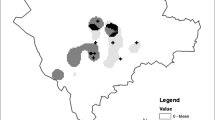Abstract
As the largest part of military usage of the territory depends on a thorough analysis of its morphology, spatial analysis with Geographic Information Systems (GIS) software reveals a great potential as a way for studying battlefields and/or other military buildings and scenarios from the past, while supporting interpretations of territorial occupation and related organization of military forces through event simulation. This paper presents a GIS-based method to model and assess the permeability of historical defensive systems from the period that preceded the mechanization of warfare of the late nineteenth century, i.e., based on artillery installed in fortifications. The method was applied to analyze the permeability of the Lines of Torres Vedras (LTV) defensive system, a multi-line fortification complex which was operational during the Peninsular War in the beginning of the nineteenth century and located north of Lisbon, Portugal. The structures of the LTV and local terrain were modelled in GIS using a set of proposed parameters that support territorial analysis, combined with the capability of contemporary weaponry. A methodical quantification and combination of these parameters enabled a better understanding of the systemic design of the defensive lines in terms of its permeability, contributing to a discussion of the LTV particular military setting based on the interpretation of these indicators. Global and sectorial analyses of the permeability of the LTV defensive system were conducted.












Similar content being viewed by others
References
Athanson, M. (2006). Modelling bullet trajectories on historic battlefields using exterior ballistic simulation and target-oriented visibility. Archaeological Computing Newsletter 65: 1–7.
César, V. J. (1910). Invasões Francesas em Portugal: 3ª Parte-Invasão Francesa de 1810, Tipografia da Cooperativa Militar, Lisbon.
Cusick, R. (2013). Wellington’s Rifles: The Origins, Development and Battles of the Rifle Regiments in the Peninsular War and at Waterloo from 1758 to 1815, Pen and Sword, Barnsley.
DIEP (Direção de Infraestruturas do Exército Português) (n.d.). Localização das fortificações das Linhas de Torres Vedras, KML file, internal document of the Portuguese Army.
Drexler, C. (2004). Using GIS to identify possible artillery positions and manage artifact data at Wilson’s Creek National Battlefield. In Henry, M., and Armstrong, L. (eds.), Mapping the Future of America’s National Parks, US National Park Service, Washington, DC, pp. 58–59.
Ehlen, J., and Whisonant, R. C. (2008). Military geology of Antietam battlefield, Maryland, USA-geology, terrain, and casualties. Geology Today 24(1): 20–27.
Ferraz, I. (1909). Memória sobre as Linhas de Torres Vedras, Revista de Artilharia 2 anno 1: 72–75.
Giordano, A., and Nolan, T. (2007). Civil War maps of the Battle of Stones River: history and the modern landscape. Cartographic Journal 44(1): 55–70.
Harvey, R. (2009). The War of Wars: The Epic Struggle Between Britain and France: 1789–1815, Constable, London.
Knowles, A., Roush, W., Abshere, C., Farrell, L., Feinberg, A., Humber, T., Kuzzy, G., and Wirene, C. (2008). What Could Lee See at Gettysburg? In Placing History: How Maps, Spatial Data, and GIS are Changing Historical Scholarship, ESRI Press, Redlands.
Lacey, C. (2003). Fireshed: The Application of GIS Techniques to Historic Military Data. MSc dissertation, University of Southampton, UK.
Luna, I., Sousa, A. C. and Leal, R. S. (2009). Telegrafia visual na Guerra Peninsular. 1807–1814. Boletim Cultural 2008, Câmara Municipal de Mafra, Mafra.
Maio, C. V., Tenenbaum, D. E., Brown, C. J., Mastone, V. T., and Gontz, A. M. (2013). Application of geographic information technologies to historical landscape reconstruction and military terrain analysis of an American Revolution Battlefield: preservation potential of historic lands in urbanized settings, Boston, Massachusetts, USA. Journal of Cultural Heritage 14(4): 317–331.
Martindale, A., and Supernant, K. (2009). Quantifying the defensiveness of defended sites on the northwest coast of North America. Journal of Anthropological Archaeology 28(2): 191–204.
Norris, A. H., and Bremner, R. W. (2001). As Linhas de Torres Vedras, as Três Primeiras Linhas e as Fortificações a Sul do Tejo, Câmara Municipal de Torres Vedras, Torres Vedras.
Oman, C. (1996). A History of the Peninsular War. Volume III: September 1809 to December 1810. Ocaña, Cadiz, Bussaco, Torres Vedras, Greenhill, London.
Pinto, A. S. (2011). A Estratégia e a Táctica de Wellington para a Defesa de Portugal. In Monteiro, M. C. (coord.) As Linhas de Torres Vedras: Um Sistema Defensivo a Norte de Lisboa, Plataforma Intermunicipal para as Linhas de Torres, Torres Vedras, pp. 85–141.
Rua, H., Gonçalves, A. B., and Figueiredo, R. (2013). Assessment of the Lines of Torres Vedras defensive system with visibility analysis. Journal of Archaeological Science 40(4): 2113–2123.
Tucci, M., and Giordano, A. (2011). Positional accuracy, positional uncertainty, and feature change detection in historical maps: results of an experiment. Computers, Environment and Urban Systems 35(6): 452–463.
Ventura, A. (2011). Contextualizar as Linhas. In Monteiro, M.C. (coord.) As Linhas de Torres Vedras: Um Sistema Defensivo a Norte de Lisboa, Plataforma Intermunicipal para as Linhas de Torres, Torres Vedras, pp. 15–83.
Wise, T. (1979). Artillery Equipment of the Napoleonic Wars, Osprey, London.
Acknowledgments
The authors would like to thank the reviewers for the valuable comments and suggestions that helped to improve the content. Authors Alexandre Gonçalves and José Almeida dedicate this paper to the memory of co-author Helena Rua (†2015), whose enthusiastic dedication to the study of the Lines of Torres Vedras was a driving force for this research.
Author information
Authors and Affiliations
Corresponding author
Additional information
Helena Rua is deceased.
Rights and permissions
About this article
Cite this article
Gonçalves, A.B., Almeida, J. & Rua, H. Assessment of the Permeability of Historical Defensive Systems: the Case of the Lines of Torres Vedras. Int J Histor Archaeol 20, 229–248 (2016). https://doi.org/10.1007/s10761-016-0334-9
Published:
Issue Date:
DOI: https://doi.org/10.1007/s10761-016-0334-9




